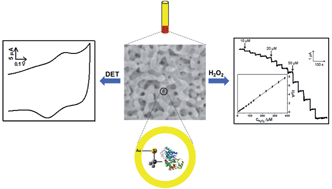Direct electrochemistry and bioelectrocatalysis of horseradish peroxidase entrapped in a self-supporting nanoporous gold electrode: a new strategy to improve the orientation of immobilized enzymes†
Abstract
The single redox active center (heme) is located deeply and asymmetrically in horseradish peroxidase (HRP), leading to a low direct electron transfer efficiency of HRP with random orientation on plane electrodes. To improve its orientation and availability, HRP was attempted to be embedded into a porous material in this study, benefiting from the encapsulation of nanopores. A self-supporting nanoporous gold electrode (NPGE) was preferred and first prepared in a water/air-stable ionic liquid ([choline]Cl·2ZnCl2) using an electrochemical alloying/dealloying method. To obtain suitable pores for HRP, the effect of temperature, which was a key factor for the formation of the Au–Zn alloy, on the morphology of the NPGE was investigated, realizing the temperature control for the pore size. The direct electrochemistry and bioelectrocatalysis of HRP embedded into the suitable nanopores were investigated detailedly. The proportion of the enzyme molecules with effective direct electron transfer was as high as 85.8% of the total amount of the immobilized HRP. The apparent electron transfer rate constant was calculated to be (2.04 ± 0.12) s−1. This biosensor displayed an excellent and rapid electrocatalytic response to H2O2 at a low overpotential with a linear range of 10–380 μM, a sensitivity of 21 μA mM−1 and a detection limit of 2.6 μM (S/N = 3), and it possessed good stability, reproducibility and selectivity for H2O2. This easy but effective strategy is not only favorable for improving the orientation of HRP in nanopores, but also takes advantage of the electron acceleration of the nano-ligaments of NPG, expanding the application field of NPG in electrochemical biosensors.


 Please wait while we load your content...
Please wait while we load your content...